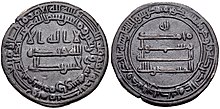Anarchy at Samarra
Abbasid Caliphate اَلْخِلَافَةُ ٱلْعَبَّاسِيَّةُ | |
|---|---|
| 861–870 | |
 Abbasid Caliphate at the time of al-Mutawakkil's death in c. 861 | |
| Capital | Samarra |
| Common languages | Arabic |
| Religion | Sunni Islam |
| Government | Caliphate |
| Caliph | |
• 861–862 | Al-Muntasir |
• 862–866 | Al-Musta'in |
• 866–869 | Al-Mu'tazz |
• 869–870 | Al-Muhtadi |
| History | |
• Assassination of al-Mutawakkil began the Anarchy at Samarra. | 861 |
• Deposition and murder of al-Muhtadi. | 870 |
The Anarchy at Samarra (
The term derives from the then capital and seat of the caliphal court,

Although the Abbasid Caliphate was able to stage a modest recovery in the following decades, the troubles of the "Anarchy at Samarra" inflicted great and lasting damage on the structures and prestige of the Abbasid central government, encouraging and facilitating secessionist and rebellious tendencies in the Caliphate's provinces.

Al-Muntasir (861–862)

Al-Musta'in (862–866)
After the death of the previous Caliph, al-Muntasir (who had not appointed any successors), the Turkic military leaders held a council to select his successor. They were not willing to have al-Mu'tazz or his brothers; so they elected Ahmad ibn Muhammad, son of the Abbasid prince
Instead of finding refuge at Medina, al-Musta'in found himself kept in Baghdad. There he was put to death on 17 October 866 by the order of al-Mu'tazz. Carrying al-Musta'in's head to the Caliph, "Here," cried the executioner, "behold thy cousin's head!" "Lay it aside," answered al-Mu'tazz who was playing chess, "till I have finished the game." And then, having satisfied himself that it was really al-Musta'in's head, he commanded 500 pieces to be given to the assassin as his reward.[citation needed]
Al-Mu'tazz (866–869)
Originally named as the second in line of three heirs of his father
As a result, by 869 the Turkic leaders Salih ibn Wasif (the son of Wasif al-Turki) and Ba'ikbak were again in the ascendant and secured the removal of Ahmad ibn Isra'il.[9] Finally, unable to meet the financial demands of the Turkic troops, in mid-July a palace coup deposed al-Mu'tazz. He was imprisoned and maltreated to such an extent that he died after three days, on 16 July 869.[9] He was succeeded by his cousin al-Muhtadi.[9]
Al-Muhtadi (869–870)
After the deposition and murder of his cousin al-Mu'tazz (r. 866–869) on 15 July 869, the leaders of the Turkic guard chose al-Muhtadi as the new Caliph on 21/22 July.[11] As a ruler, al-Muhtadi sought to emulate the Caliph Umar ibn Abd al-Aziz,[11] widely considered a model Islamic ruler.[12] He therefore lived an austere and pious life—notably removing all musical instruments from the court—and made a point of presiding in person over the courts of grievances (mazalim), thus gaining the support of the common people.[11][13] Combining "strength and ability", he was determined to restore the Caliph's authority and power,[11] that had been eroded during the ongoing "Anarchy at Samarra" by the squabbles of the Turkish generals.[14] Al-Muhtadi faced Alid risings in the provinces, but the main threat to his power was the Turkic commanders.[11]
When Musa ibn Bugha left to campaign against the Kharijites, al-Muhtadi took the opportunity to incite the people against him and his brother, Muhammad ibn Bugha. Muhammad was brought to trial on accusations of embezzlement and was condemned. Although al-Muhtadi had promised a pardon, Muhammad was executed. This cemented the rift with Musa: the latter marched on the capital with his army and defeated the troops loyal to the Caliph. He refused to abdicate but tried to preserve his life and office by recourse to the religious status of the caliph, and the support of the people. He was nevertheless murdered on 21 June 870, and replaced by his cousin, al-Mu'tamid (r. 870–892).[11]
Aftermath

At the end of Anarchy at Samarra, a rebellion broke out famously known as Zanj Rebellion. It grew to involve slaves and freemen, including both Africans and Arabs, from several regions of the Caliphate and claimed tens of thousands of lives before it was finally defeated.[15]
Several
References
- ^ Bosworth, "al-Muntasir" 1993, p. 583.
- ^ Kennedy 2006, pp. 266–268.
- ^ Gordon 2001, pp. 88–91.
- ^ Saliba 1985, pp. 106–108.
- ^ Saliba 1985, p. 113.
- ^ Kennedy 2001, pp. 138–139.
- ^ Kennedy 2001, p. 138.
- ^ Kennedy 2001, p. 139.
- ^ a b c d Bosworth, "al-Muʿtazz Bi’llāh" 1993, p. 794.
- ^ Kennedy 2004, p. 172.
- ^ a b c d e f Zetterstéen & Bosworth 1993, pp. 476–477.
- ^ Cobb 2000, pp. 821–822.
- ^ Kennedy 2004, p. 173.
- ^ Kennedy 2004, pp. 169–173.
- ^ a b Furlonge 1999, p. 7.
Bibliography
- ISBN 978-0-521-83823-8.
- ISBN 978-90-04-09419-2.
- Bosworth, C.E. (1993). "al-Muntasir". In ISBN 978-90-04-09419-2.
- Cobb, P. M. (2000). "ʿUmar (II) b. ʿAbd al-ʿAzīz". In ISBN 978-90-04-11211-7.
- Furlonge, Nigel D. (1999). "Revisiting the Zanj and Re-Visioning Revolt: Complexities of the Zanj Conflict – 868–883 AD". Negro History Bulletin. 62 (4): 7–14. Retrieved 4 November 2015.
- Gordon, Matthew S. (2001). The Breaking of a Thousand Swords: A History of the Turkish Military of Samarra (A.H. 200–275/815–889 C.E.). Albany, New York: State University of New York Press. ISBN 0-7914-4795-2.
- ISBN 0-415-25093-5.
- ISBN 978-0-582-40525-7.
- ISBN 978-0-306814808.
- ISBN 978-0-87395-883-7.
- Zetterstéen, K. V. & Bosworth, C. E. (1993). "al-Muhtadī". In ISBN 978-90-04-09419-2.
